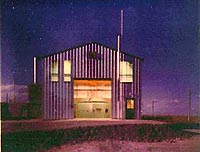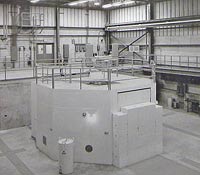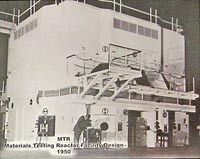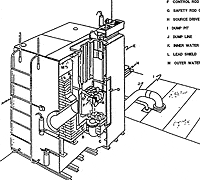Reactors Designed by Argonne National Laboratory
BOOKSHELF
 “Plentiful
Energy: The Story of the Integral Fast Reactor” by Charles E. Till and Yoon
Chang gives the history of the IFR at
Argonne. The book is available on Amazon.com.
“Plentiful
Energy: The Story of the Integral Fast Reactor” by Charles E. Till and Yoon
Chang gives the history of the IFR at
Argonne. The book is available on Amazon.com.
More about the book »
More about the IFR »
Basic and Applied Science Research Reactors
Argonne designed, built, and operated several reactors that collectively produced a vast amount
of data and analysis that drove advancements in radiation protection, biosciences, reactor design,
and evolution of materials used in reactor construction.
Back to Argonne Reactors Overview
AFSR (Argonne Fast Source Reactor)
The Argonne Fast Source Reactor (AFSR) was designed and built in 1958 near EBR-I on the National Reactor Testing Station (NRTS, which was incorporated into the new Idaho National Laboratory in 2005). AFSR was placed in operation in October of 1959 with a design power of one kilowatt.
The AFSR was designed to supplement the existing facilities of the Idaho Divison of Argonne National Laboratory. It was designed as a readily available source of both fast and thermal neutrons for use as follows:
- developing, testing, calibrating, and standardizing various counters;
- Preparation of radioactive metallic foils used in the development of counting and radiochemical techniques;
- checking out complex experimental systems before operation in other reactors;
- and development of potential experiments in the fast reactor field.
In the fall of 1970, this reactor was moved to a new location adjacent to the ZPPR facility at the ANL West site of the NRTS. The reactor is now shutdown and defueled.
Juggernaut
The Juggernaut reactor was a light-water moderated and cooled, graphite reflected research reactor with a rated thermal power of 250 kW. It operated from 1962 through 1970. The design of the reactor was similar to that of the Argonaut, which allowed the physics analysis of Juggernaut to be checked using the Argonaut as a “critical assembly”.
The purpose of the facility was to relieve the experimental load on CP-5 and provide neutron flux levels of medium intensity (up to 4.0x1012 n/cm2-sec.) for research and development experiments for Argonne's fast reactor program. These experiments included:
- Flux mapping of lattice units for proposed reactors
- Developmental activities concerning the use of reactors for fuel assaying
- Measurement of the properties of neutron waves
- Testing of new neutron-measuring instruments
- The development of cold-neutron technology The reactor contained 14 vertical facilities for irradiation experiments, four horizontal beam holes, two thermal column openings, a universal test facility, and a test cave. All vertical facilities could be accessed from the top of the reactor.
Juggernaut was located in Bldg. 335 on Rock Road at Argonne's Illinois location, just west of the Experimental Boiling Water Reactor (Bldg. 331). It reused some of the components from the Geneva Argonaut.
For more information on Jaggernaut:Moon, D. P., "Physics Analysis of the Juggernaut Reactor", ANL-6587, Argonne National Laboratory, 1962
Folkrod, J. R., et al., "Design Summary Report on the Juggernaut Reactor", ANL-6616, Argonne National Laboratory, 1962.
JANUS
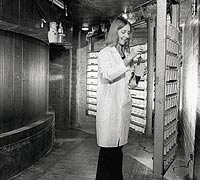
Argonne's JANUS reactor was the world's first nuclear reactor designed and built solely for biological research. Click on photo to view a larger image.
The JANUS Reactor Facility was used as a neutron source to research the biological and genetic effects of acute and chronic exposures to neutrons arising from the fission process. Janus featured a pair of rooms for irradiation experiments on opposite sides of the reactor core. Thick doors allowed neutrons from the reactor core to enter the rooms -- hence the name Janus, the two-faced Roman god of doorways.
For more information on JANUS:
A
bit of history about JANUS (Argonne News Release, Aug.3, 1996)
Decommissioning
of JANUS
MTR (Materials Testing Reactor)
The Materials Testing Reactor (MTR) was developed in a cooperative effort by Oak Ridge National
Laboratory and Argonne National Laboratory. The reactor was built at the National Reactor Testing Station. The primary purpose of the MTR was to test
under conditions of severe neutron bombardment the materials which might be used in reactor
construction (in the structures, cooling systems, or shields).
For more information about the MTR:
- The MTR—Gone now, but not forgotten - an article by Will Davis for the ANS Nuclear Cafe blog (Oct. 25, 2012)
ZPR-4 (ATSR)
The ZPR-I core and vessel were modified in 1953 to allow leakage of neutrons from the core to drive fast-spectrum exponential assemblies. Since this was the fourth Argonne zero-power experiment, the reactor was renamed ZPR-4. In 1960, after completion of the exponential experiments, the reactor was moved to another building and several modifications were made that included replacement of the core tank and modifications to the control rod and safety rod systems and the addition of a thermal column. To indicate that the reactor was used primarily as a source of neutrons, it was renamed the Argonne Thermal Source Reactor. The reactor was shut down in the late 1980s. The last of its fuel was removed in December 1992 and sent to the Savannah River Plant near Aiken, SC.
For more information on ATSR:
Decommissioning of ATSR
Related Information
- About Nuclear Energy
- Argonne’s Nuclear Energy Exhibition Hall highlights our pioneering role in developing peaceful uses of nuclear technology used by major nuclear power plants throughout the world. For more information, call (630) 252-5562 or email [email protected].
- Argonne OutLoud Lecture: How Advanced Reactors will Change Nuclear Power and the World (May 11, 2017)
- History of Argonne Reactor Operations [2.2MB]
- Nuclear Energy FAQs (Frequently Asked Questions) [[an error occurred while processing this directive]B]
- NOVA episode: The Nuclear Option: How will we power the planet without wrecking the climate? Aired January 11, 2017 on PBS
Last Modified: Wed, September 18, 2019 5:09 PM


